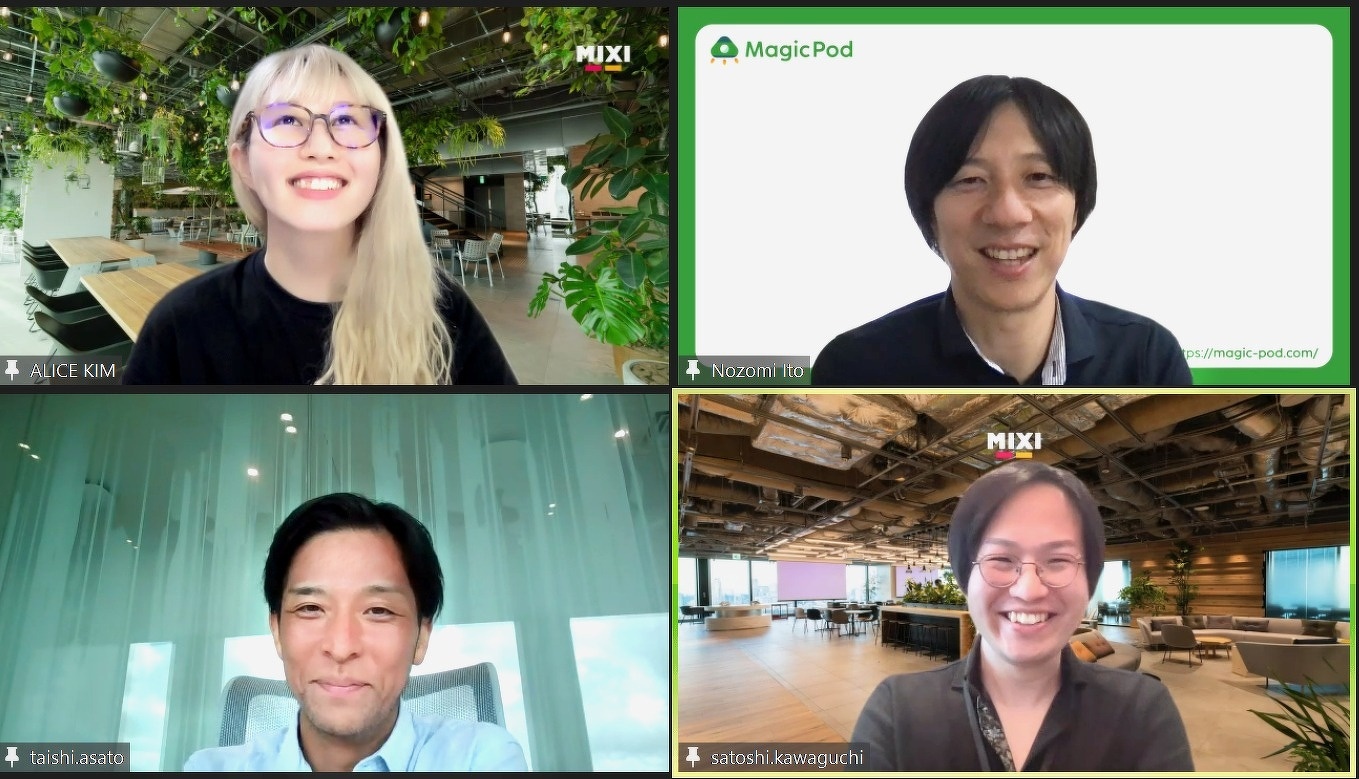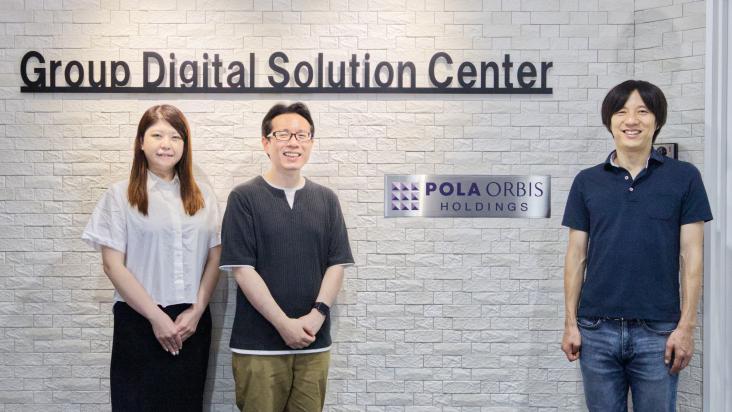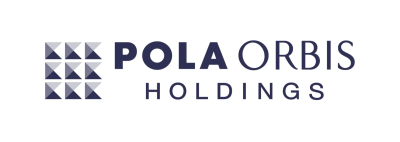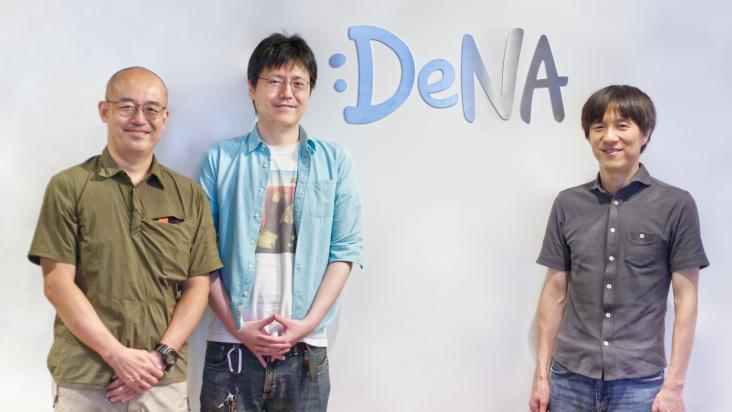MagicPod’s great because it lets you start small. Try it and you’ll see the value of automation.
MIXI, Inc.
In our 8th user interview, we spoke with MagicPod CEO, Ito, and MIXI, Inc. We spoke about a wide variety of matters, including actual use cases and what led MIXI to choose MagicPod.
MIXI, Inc. Company Overview
MIXI Group aims to create services that enrich communication around the world. They have created a broad range of communication services, including “mixi,” a social networking service that connects users with genuine friends and acquaintances over the Internet, “Monster Strike,” a multiplayer game that can be enjoyed by all ages, and “FamilyAlbum,” an app that allows users to easily share and organize photos and videos of their children. They are also embracing the challenge of creating communication in the sports domain, led by their sports betting service “TIPSTAR.”
KEY POINTS
- The MagicPod UI is easy to understand, making automation creation intuitive
- It is easy to implement thanks to monthly contracts and an unlimited number of accounts
- Work that used to take 8 to 16 hours now takes half the time
- It makes quality assurance and routine tasks a lot more efficient

MIXI, Inc.
・Taishi Asato (QA Group Manager, CTO’s Office, Development Operations)
・Kim Yeon-kyung (Alice) (QA Group, CTO’s Office, Development Operations)
・Satoshi Kawaguchi (QA Team, Development Group, minimo Business Division, Vantage Studio)
Circumstances behind MagicPod implementation
Asato-san (hereafter, “Asato”): We first implemented MagicPod in August 2021. At the start of that year, the CTO had asked us to move forward with automation, and after narrowing down our options and trying them out, we settled on MagicPod. We had explored the idea of automation before when somebody with an interest in it had tried using Selenium and Appium. However, when that person left the company, the endeavor eventually fizzled out. We realized that letting an idea die out when somebody leaves the company is not an effective way of implementing initiatives, and we were told by the CTO to avoid relying on a single person at all costs.
I joined the company in November 2015 as part of the QA (Quality Assurance) team for "Monster Strike." Although I thought it was difficult to automate games, I found it interesting and so invested time studying it on a personal level. I had heard Ito-san speak twice at JaSST (Japan Symposium on Software Testing), so when I began to take on non-gaming work as well, I was inspired to utilize automation. At the same time, however, I felt that it would be difficult to implement it as an organization.
With support from the CTO, we began to seriously consider how we could implement automation. Having heard Ito-san speak on the subject, I was aware of the existence of automation tools, and when I looked into it anew, I found the tools to be very user-friendly and that there were more than ever before. We finally selected MagicPod because it gave us confidence that we could overcome the high technical obstacles and the risk that only certain individuals would have knowledge of the testing approach.
Reasons for deciding on MagicPod
Asato: After using MagicPod on a trial basis, I felt that it could accomplish what I wanted to do in a smooth manner. Part of the reason might be because I had a programming background, so it felt pretty intuitive for me and did what I expected for the most part. That said, I wouldn't be surprised if someone without programming knowledge could write simple test cases after a 15-minute explanation. Although there is a jump in the difficulty level once you start using branches and variables, if you contact customer support, you can get a response very quickly. So, even if you get stuck, you can rest assured that the problem will be solved quickly.
Alice-san (hereafter, Alice): I joined the company in October 2021, so even though I was not involved in the selection process, I had actually recommended MagicPod when the implementation of an automation tool was discussed at my previous job. At first, I tried to automate testing by writing code in Python and Selenium. However, I felt like those would be too difficult for non-programmers to use. While I was trying out automation tools, I found that MagicPod was easy to understand in terms of UI, and since I was able to intuitively make automations, I told my manager that MagicPod is the way to go.
Asato: In addition to being easy to use, another major factor in our decision to adopt MagicPod was the ability to make monthly contracts. Other tools required annual contracts, which we considered to be a major obstacle to implementation. It was also helpful that there was no limit to the number of accounts that could be issued. When we announced the introduction of the system on our internal channel dedicated to automation, many people, including engineers, asked us to issue them with an account as they wanted to try using the system. We have issued about 80 accounts thus far; of these, the number of people who have actually created test cases and are actively using the system is around 30. Most of the users simply wanted to try it out, and thanks to the number of accounts being unlimited, they were all able to use the system. From a cost perspective, the ability to start small is another advantage of MagicPod.
MagicPod use cases
Asato: MagicPod is currently used in six or seven services at MIXI, including "MIXI M," a mobile wallet app that I oversee, "Fansta," a service for finding and reserving sports bars that Alice is in charge of, "minimo," a beauty salon app that Kawaguchi is in charge of, as well as “TIPSTAR” and others. Incidentally, our QA team meets once a month with Net Dreamers, a subsidiary that operates "netkeiba.com." They became interested in MagicPod after we introduced it to them and started using it as a way to review their outsourced work.
For "MIXI M," which I am in charge of, we use MagicPod for part of our regression testing. We need to carry out regression testing every time a change is made, and to be honest, it is not a very enjoyable process. Because of this, my attitude used to be "I don't have time, so I'll just do the important parts," or "I'll just do the important payment-related tests." MagicPod has automated about 70% of this, so we can test as much as we want until we feel comfortable. It provides real peace of mind in knowing that it can be implemented at any time, and I am able to devote the time I saved to difficult areas, such as test design.
Alice: I am in charge of "Fansta," and we run regression tests regularly every morning at 9:00 and 10:00. Test result notifications are sent to Slack, and details are available when the tests fail. The work—which used to take two or three hours before we introduced the system—has been automated, and this has really allowed us to reduce costs.
Kawaguchi-san (hereafter, “Kawaguchi”): I am in charge of "minimo," a reservation service for beauty salons, and we run regression tests on two types of web services provided for customers and for publishers. With MagicPod, we were able to automate 70–80% of the work, cutting in half what used to take 8–16 hours. Despite also having a “minimo” app and constantly expanding our services, we are able to ensure thorough quality assurance thanks to MagicPod.
Additionally, MagicPod is incredibly useful when routine work is required for testing and creating environments. For example, if we want to upload and delete 300 photos, we no longer need to consult the development team about the time-consuming routine work required for creating the environment—the QA team can create it ourselves with MagicPod.
Asato: For another service, we previously had to manually input the same thing about 100 times every morning for QA testing, but now MagicPod does it for us every morning, which has dramatically streamlined our work. I think it plays a role not only in terms of quality assurance, but also in automating simple tasks to increase efficiency.
The secret to smooth MagicPod implementation
Ito (MagicPod CEO): What often happens when implementing automation is that a few motivated people take the initiative and, while this works at first, it is hard to get others interested, and so it does not continue after that. However, I get the impression that it has permeated your company quite smoothly.
Asato: One of the factors was that the CTO had a strong will to implement this. As I was in charge of six projects at that time, I could implement automation in all of them simultaneously. But more than that, I think it was also due to the culture of MIXI, where many of our engineers are willing to put in the effort to improve the quality of our products. When the QA staff told others about using a tool called MagicPod for automations, the engineers were very interested and eager to get involved. Of course, there are some things you can't automate without the help of engineers, so this was very helpful.
Alice: For example, there was a case in "Fansta" where we needed to get past IAP/2-step verification in order to run MagicPod. Thanks to the cooperation of the SRE (Site Reliability Engineering) group, the product owner, and our internal IT division, we were able to run it according to schedule every morning.
Ito: It seems you have an excellent company culture! Does the entire QA team collectively share information and review test results?
Asato: It is not in the form of a review, but we do set aside time once a week where everyone performs maintenance. We run a series of tests and, if there are any issues, we fix them all together until everything runs smoothly. This allows us to maintain tests in a state where they do not fail or break, and also helps spread knowledge about MagicPod more widely.
Ito: Having a weekly maintenance day is a truly unique concept. I have never heard of this before.
Asato: We first introduced it when one member suggested we all use MagicPod once a week for two hours. I thought it was a good idea because everyone has to interact with it. Once you interact with it, you will understand the benefits of it. This may be the key to a smooth introduction. I am grateful to the member who suggested it. Rather than creating a dedicated automation team, we follow the fundamental principle of “we all do it together.” Doing complicated things that require expertise could become a future liability, so we try to do things that everyone can do and things that can be done with MagicPod.
Finally...
Asato: What I experience when using MagicPod is the “joy of making things.” It's like using my brain in the same way as when programming. Either it works or fails; if it fails, I try to discover the reason behind the failure. It is a great feeling when you succeed, and I think automated testing lets you succeed more easily. With MagicPod, you can start off cheaply by using it on a monthly basis, and so I’d recommend just trying it out. If you use it for a week, you will definitely see the value of automation.
Alice: It is the easiest to use and understand out of all the automation tools I have used so far. Even people with no programming knowledge can use it. You should definitely try it on a trial basis!
Kawaguchi: I also recommend it as it’s so easy to use. Even people with no programming experience can quickly write automations. The commands are simple and easy to understand, and automations can largely be created by using just your mouse. Receiving quick support when an issue occurs is also a clear benefit. Overall, it is a good tool for first-time users, as it allows them to gain experience with automation.
Notifications
MIXI is looking for people interested in promoting communication with us!
・Hiring information
・@mixi_engineers
(A wide range of announcements and technical information can be found on our pages above!)








